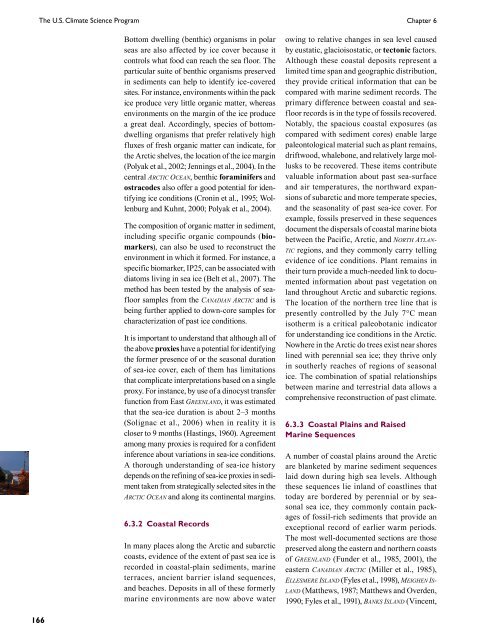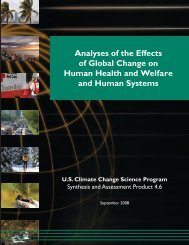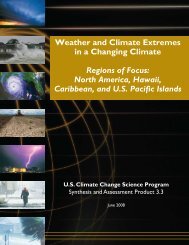Past Climate Variability and Change in the Arctic and at High Latitudes
Past Climate Variability and Change in the Arctic and at High Latitudes
Past Climate Variability and Change in the Arctic and at High Latitudes
Create successful ePaper yourself
Turn your PDF publications into a flip-book with our unique Google optimized e-Paper software.
166<br />
The U.S. <strong>Clim<strong>at</strong>e</strong> Science Program<br />
Bottom dwell<strong>in</strong>g (benthic) organisms <strong>in</strong> polar<br />
seas are also affected by ice cover because it<br />
controls wh<strong>at</strong> food can reach <strong>the</strong> sea floor. The<br />
particular suite of benthic organisms preserved<br />
<strong>in</strong> sediments can help to identify ice-covered<br />
sites. For <strong>in</strong>stance, environments with<strong>in</strong> <strong>the</strong> pack<br />
ice produce very little organic m<strong>at</strong>ter, whereas<br />
environments on <strong>the</strong> marg<strong>in</strong> of <strong>the</strong> ice produce<br />
a gre<strong>at</strong> deal. Accord<strong>in</strong>gly, species of bottomdwell<strong>in</strong>g<br />
organisms th<strong>at</strong> prefer rel<strong>at</strong>ively high<br />
fluxes of fresh organic m<strong>at</strong>ter can <strong>in</strong>dic<strong>at</strong>e, for<br />
<strong>the</strong> <strong>Arctic</strong> shelves, <strong>the</strong> loc<strong>at</strong>ion of <strong>the</strong> ice marg<strong>in</strong><br />
(Polyak et al., 2002; Jenn<strong>in</strong>gs et al., 2004). In <strong>the</strong><br />
central <strong>Arctic</strong> oceAn, benthic foram<strong>in</strong>ifers <strong>and</strong><br />
ostracodes also offer a good potential for identify<strong>in</strong>g<br />
ice conditions (Cron<strong>in</strong> et al., 1995; Wollenburg<br />
<strong>and</strong> Kuhnt, 2000; Polyak et al., 2004).<br />
The composition of organic m<strong>at</strong>ter <strong>in</strong> sediment,<br />
<strong>in</strong>clud<strong>in</strong>g specific organic compounds (biomarkers),<br />
can also be used to reconstruct <strong>the</strong><br />
environment <strong>in</strong> which it formed. For <strong>in</strong>stance, a<br />
specific biomarker, IP25, can be associ<strong>at</strong>ed with<br />
di<strong>at</strong>oms liv<strong>in</strong>g <strong>in</strong> sea ice (Belt et al., 2007). The<br />
method has been tested by <strong>the</strong> analysis of seafloor<br />
samples from <strong>the</strong> cAnAdiAn <strong>Arctic</strong> <strong>and</strong> is<br />
be<strong>in</strong>g fur<strong>the</strong>r applied to down-core samples for<br />
characteriz<strong>at</strong>ion of past ice conditions.<br />
It is important to underst<strong>and</strong> th<strong>at</strong> although all of<br />
<strong>the</strong> above proxies have a potential for identify<strong>in</strong>g<br />
<strong>the</strong> former presence of or <strong>the</strong> seasonal dur<strong>at</strong>ion<br />
of sea-ice cover, each of <strong>the</strong>m has limit<strong>at</strong>ions<br />
th<strong>at</strong> complic<strong>at</strong>e <strong>in</strong>terpret<strong>at</strong>ions based on a s<strong>in</strong>gle<br />
proxy. For <strong>in</strong>stance, by use of a d<strong>in</strong>ocyst transfer<br />
function from East GreenlAnd, it was estim<strong>at</strong>ed<br />
th<strong>at</strong> <strong>the</strong> sea-ice dur<strong>at</strong>ion is about 2–3 months<br />
(Solignac et al., 2006) when <strong>in</strong> reality it is<br />
closer to 9 months (Hast<strong>in</strong>gs, 1960). Agreement<br />
among many proxies is required for a confident<br />
<strong>in</strong>ference about vari<strong>at</strong>ions <strong>in</strong> sea-ice conditions.<br />
A thorough underst<strong>and</strong><strong>in</strong>g of sea-ice history<br />
depends on <strong>the</strong> ref<strong>in</strong><strong>in</strong>g of sea-ice proxies <strong>in</strong> sediment<br />
taken from str<strong>at</strong>egically selected sites <strong>in</strong> <strong>the</strong><br />
<strong>Arctic</strong> oceAn <strong>and</strong> along its cont<strong>in</strong>ental marg<strong>in</strong>s.<br />
6.3.2 Coastal Records<br />
In many places along <strong>the</strong> <strong>Arctic</strong> <strong>and</strong> subarctic<br />
coasts, evidence of <strong>the</strong> extent of past sea ice is<br />
recorded <strong>in</strong> coastal-pla<strong>in</strong> sediments, mar<strong>in</strong>e<br />
terraces, ancient barrier isl<strong>and</strong> sequences,<br />
<strong>and</strong> beaches. Deposits <strong>in</strong> all of <strong>the</strong>se formerly<br />
mar<strong>in</strong>e environments are now above w<strong>at</strong>er<br />
Chapter 6<br />
ow<strong>in</strong>g to rel<strong>at</strong>ive changes <strong>in</strong> sea level caused<br />
by eust<strong>at</strong>ic, glacioisost<strong>at</strong>ic, or tectonic factors.<br />
Although <strong>the</strong>se coastal deposits represent a<br />
limited time span <strong>and</strong> geographic distribution,<br />
<strong>the</strong>y provide critical <strong>in</strong>form<strong>at</strong>ion th<strong>at</strong> can be<br />
compared with mar<strong>in</strong>e sediment records. The<br />
primary difference between coastal <strong>and</strong> seafloor<br />
records is <strong>in</strong> <strong>the</strong> type of fossils recovered.<br />
Notably, <strong>the</strong> spacious coastal exposures (as<br />
compared with sediment cores) enable large<br />
paleontological m<strong>at</strong>erial such as plant rema<strong>in</strong>s,<br />
driftwood, whalebone, <strong>and</strong> rel<strong>at</strong>ively large mollusks<br />
to be recovered. These items contribute<br />
valuable <strong>in</strong>form<strong>at</strong>ion about past sea-surface<br />
<strong>and</strong> air temper<strong>at</strong>ures, <strong>the</strong> northward expansions<br />
of subarctic <strong>and</strong> more temper<strong>at</strong>e species,<br />
<strong>and</strong> <strong>the</strong> seasonality of past sea-ice cover. For<br />
example, fossils preserved <strong>in</strong> <strong>the</strong>se sequences<br />
document <strong>the</strong> dispersals of coastal mar<strong>in</strong>e biota<br />
between <strong>the</strong> Pacific, <strong>Arctic</strong>, <strong>and</strong> north AtlAntic<br />
regions, <strong>and</strong> <strong>the</strong>y commonly carry tell<strong>in</strong>g<br />
evidence of ice conditions. Plant rema<strong>in</strong>s <strong>in</strong><br />
<strong>the</strong>ir turn provide a much-needed l<strong>in</strong>k to documented<br />
<strong>in</strong>form<strong>at</strong>ion about past veget<strong>at</strong>ion on<br />
l<strong>and</strong> throughout <strong>Arctic</strong> <strong>and</strong> subarctic regions.<br />
The loc<strong>at</strong>ion of <strong>the</strong> nor<strong>the</strong>rn tree l<strong>in</strong>e th<strong>at</strong> is<br />
presently controlled by <strong>the</strong> July 7°C mean<br />
iso<strong>the</strong>rm is a critical paleobotanic <strong>in</strong>dic<strong>at</strong>or<br />
for underst<strong>and</strong><strong>in</strong>g ice conditions <strong>in</strong> <strong>the</strong> <strong>Arctic</strong>.<br />
Nowhere <strong>in</strong> <strong>the</strong> <strong>Arctic</strong> do trees exist near shores<br />
l<strong>in</strong>ed with perennial sea ice; <strong>the</strong>y thrive only<br />
<strong>in</strong> sou<strong>the</strong>rly reaches of regions of seasonal<br />
ice. The comb<strong>in</strong><strong>at</strong>ion of sp<strong>at</strong>ial rel<strong>at</strong>ionships<br />
between mar<strong>in</strong>e <strong>and</strong> terrestrial d<strong>at</strong>a allows a<br />
comprehensive reconstruction of past clim<strong>at</strong>e.<br />
6.3.3 Coastal Pla<strong>in</strong>s <strong>and</strong> Raised<br />
Mar<strong>in</strong>e Sequences<br />
A number of coastal pla<strong>in</strong>s around <strong>the</strong> <strong>Arctic</strong><br />
are blanketed by mar<strong>in</strong>e sediment sequences<br />
laid down dur<strong>in</strong>g high sea levels. Although<br />
<strong>the</strong>se sequences lie <strong>in</strong>l<strong>and</strong> of coastl<strong>in</strong>es th<strong>at</strong><br />
today are bordered by perennial or by seasonal<br />
sea ice, <strong>the</strong>y commonly conta<strong>in</strong> packages<br />
of fossil-rich sediments th<strong>at</strong> provide an<br />
exceptional record of earlier warm periods.<br />
The most well-documented sections are those<br />
preserved along <strong>the</strong> eastern <strong>and</strong> nor<strong>the</strong>rn coasts<br />
of GreenlAnd (Funder et al., 1985, 2001), <strong>the</strong><br />
eastern cAnAdiAn <strong>Arctic</strong> (Miller et al., 1985),<br />
elleSMere iSlAnd (Fyles et al., 1998), MeiGhen iSlAnd<br />
(M<strong>at</strong><strong>the</strong>ws, 1987; M<strong>at</strong><strong>the</strong>ws <strong>and</strong> Overden,<br />
1990; Fyles et al., 1991), bAnkS iSlAnd (V<strong>in</strong>cent,




